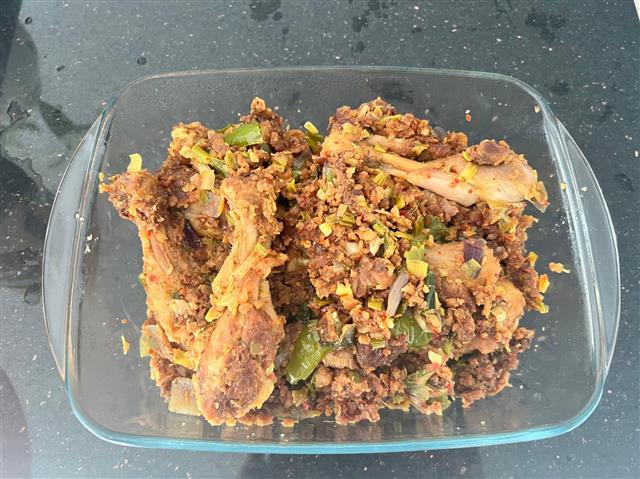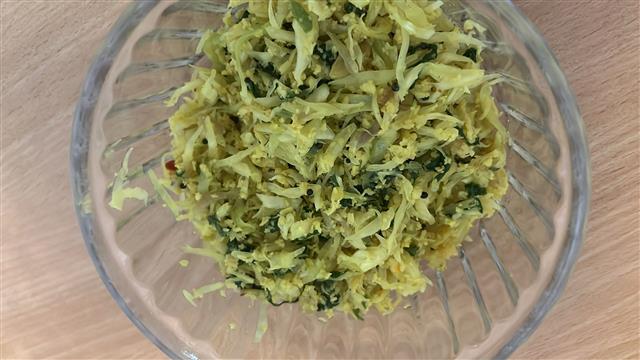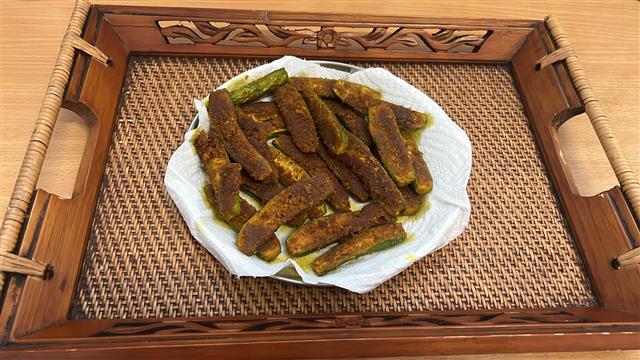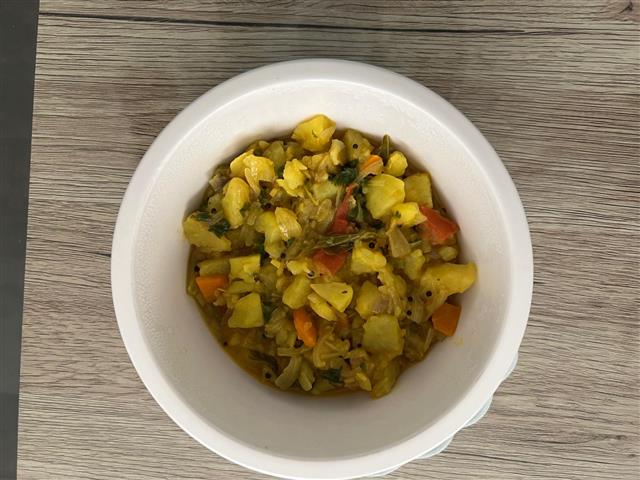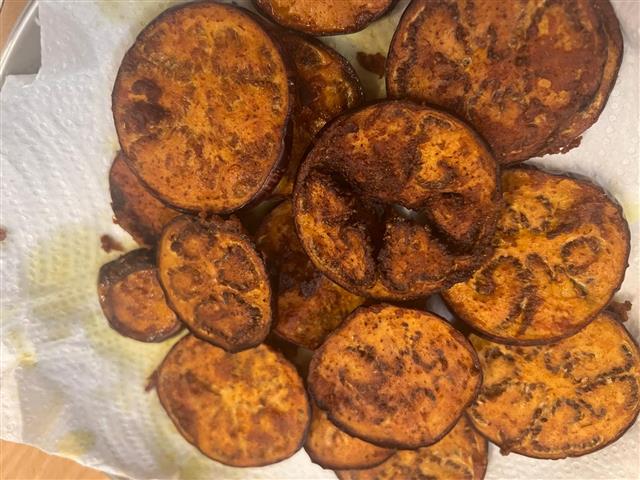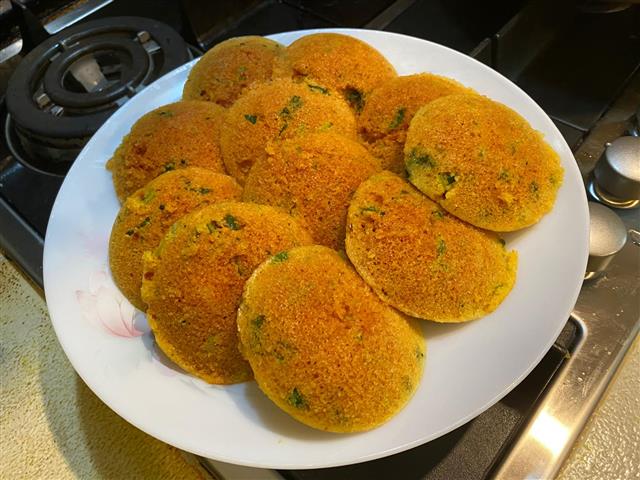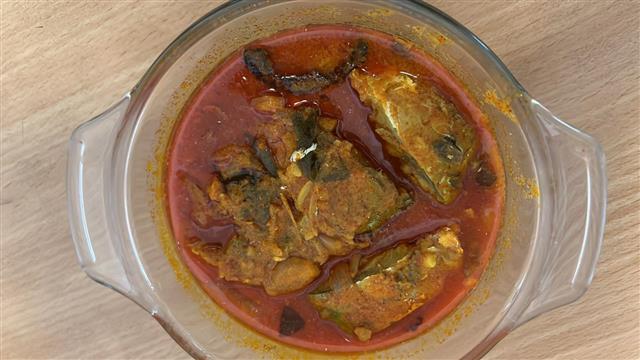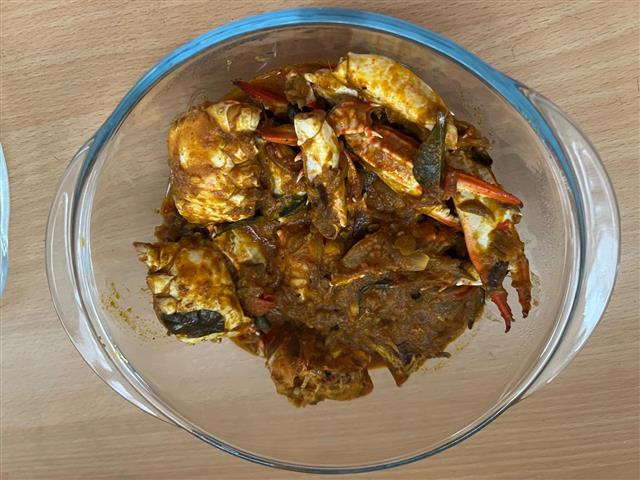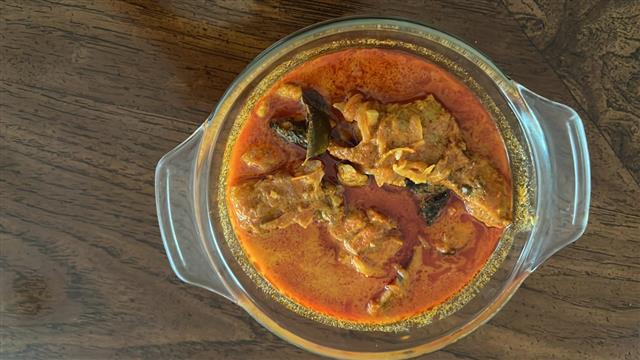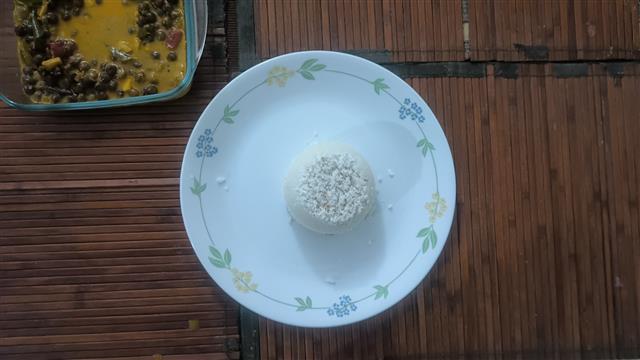
Potato Mezhukkupuratti
(4 reviews)
A humble Kerala-style stir-fried dish made with boiled potatoes, onions, curry leaves, and red chillies.
Cooked without coconut or spice powders, it is gently roasted in oil until the edges of the potatoes turn crispy. This golden crisp of the potato with the heat of red chillies makes it a warm, comforting classic.
Simple, hearty, and satisfying, Potato Mezhukupuratti is a common side dish on lunch tables across the state.
Ingredients
Directions
- Place the potato cubes in a pot and cover with water. Add salt and bring to a boil. Cook until the potatoes are just tender but not falling apart, about 8-10 minutes. Drain and set aside.
- Heat the oil in a large frying pan or kadai over medium heat. Add the mustard seeds and let them splutter. Then add the dry red chilies and curry leaves, frying for a few seconds until aromatic.
- Blend the onion and red chili in a mixer, Add the sliced onions to the pan and sauté until they turn golden brown and soft.
- Incorporate red chili and boiled potatoes, Add the boiled potatoes to the pan with salt to taste. Stir well to combine, ensuring the potatoes are evenly coated with the spices and onions.
- Continue to stir-fry the mixture for another 5-10 minutes over medium heat until the potatoes are dry and slightly crispy on the outside
- Check the seasoning and adjust the salt if necessary. Remove from heat and serve the Potato Mezhukkupuratti hot as a side dish with rice or roti.
Cooking Tips
→ Use firm, waxy potatoes for best results. They hold their shape better during boiling and sautéing.
→ Cut the potato cubes evenly so they cook uniformly. Uneven pieces may break apart while stir-frying.
→ Some home cooks like to add a crushed garlic clove or two during the tempering for added aroma, although it's optional.
How to Serve
→ Rice, moru curry, and pappadam
→ Parippu Curry (lentils) and ghee rice
→ Rotis or chapatis, for guests
→ Chena (yam), or Beans Thoran for a fuller meal
The Story Behind Potato Mezhukkupuratti
While Mezhukkupuratti is a very traditional and native Kerala cooking method, the use of potatoes is a relatively modern twist in its long story. Historically, vegetables like raw banana (kaya), elephant foot yam (chena), long beans (achinga payar), or koorka (Chinese potato) were the classic bases for this preparation.
Potato, not indigenous to Kerala, was introduced more prominently during the colonial era and became a pantry staple in many homes by the mid-20th century, particularly in Christian and urban households. Over time, this tuber became part of the Malayali diet, valued for its versatility, long shelf life, and how well it absorb flavours.
Unlike coconut-based dishes, Potato Mezhukkupuratti doesn't spoil quickly, making it a favourite for lunchboxes, train journeys, or next-day leftovers.
In many families, this dish holds nostalgic value. It's one of the first things taught to children who are learning to cook or students moving away from home. It's forgiving, easy to master, and deeply satisfying. The recipe also reflects the broader philosophy of Kerala home cooking: frugality, balance, and depth of taste without extravagance.
It may look simple on the plate, but in practice, it requires patience. To sauté, to stir, and to let the edges crisp just enough without burning. It's often said that the best Mezhukkupuratti is made not with ingredients alone, but with time and instinct.
What Is Potato Mezhukkupuratti?
A dry stir-fry made using boiled potatoes lightly fried in oil along with a few essential ingredients like onions, red chillies, mustard seeds, and curry leaves.
What sets this style apart is its simplicity. Minimal ingredients, no spice powders, no coconut milk, and no gravy. Instead, it relies on slow-roasting in oil (mezhukku), allowing each ingredient to shine through and to deepen the flavour.
It is usually part of the everyday vegetarian meal in Kerala, often served alongside rice and a simple curry such as moru, sambar, or parippu. It's also served during Sadya in certain parts of Kerala as a less-spicy, child-friendly option, often replacing yam or raw banana versions.
In temple kitchens, the same method is used for chembu (colocasia), vazhakka (raw plantain), and payaru (green gram), though the potato variation is a newer one and highly popular in urban areas.
Pro Tips for Perfect Results
→ Don't overcook the potatoes in the boiling step. They should be just fork-tender, not mushy.
→ Allow the onion and chilli mixture to brown slowly. This is what gives the dish its rich, slightly sweet tang.
→ Let the stir-fried potatoes sit undisturbed in the pan for a few seconds at a time to help the crisping process. Stirring often can prevent the much-needed browning.
Potato Mezhukkupuratti Variations
→ With Garlic In some Central Kerala homes, crushed garlic is sautéed along with the onions to bring in extra depth and aroma.
→ With Green Chillies Instead of dry red chillies, some households use slit green chilli for more heat. This is common in Palakkad and Malappuram regions.
→ With Coconut or Sesame Oil Traditionally, coconut oil is the default cooking medium, especially in southern districts. Marachekku Gingelly oil adds a distinct flavour.
→ Masala Style A spicier version sometimes includes a pinch of turmeric and a spoonful of crushed black pepper added towards the end, especially in households that prefer a bolder bite.
→ Mixed Vegetable Mezhukkupuratti Potatoes are often combined with other vegetables like carrots, beans, or raw bananas to make a colorful, textured version of this dry fry.
Diet-Friendly Adaptations
→ Vegan This dish is naturally vegan as it contains no dairy or animal products.
→ Gluten-Free All ingredients are naturally gluten-free, making it a safe side dish for those with gluten intolerance or celiac disease.
→ Low-Oil Version For a lighter option, use just 1 tablespoon of oil and dry roast the ingredients slowly over low heat. A non-stick or cast-iron pan can help achieve a good texture with minimal oil.
→ Low-Carb/Keto Alternative Substitute potatoes with turnips or zucchini, though it may not taste the same. It's a decent option for those watching their carb intake.
Storing & Reheating Tips
→ Store: Let it cool completely before transferring to an airtight container. Otherwise, the potatoes become soggy from condensation.
→ Fridge: Make ahead and store in the fridge for 2–3 days.
→ Reheat: Sprinkle a few drops of water and warm it up in a covered pan over low heat. This prevents the potatoes from drying out. Avoid microwaving as it softens the crispy edges.
→ Freeze: Not recommended, as boiled potatoes can become grainy or watery when thawed.
Common Mistakes to Avoid
→ Overcooking the Potatoes: Boil just until tender, not mushy. Overcooked potatoes fall apart during stir-frying and make the dish lumpy.
→ Using Too Much Oil: While it's called mezhukkupuratti, the goal is to coat the ingredients lightly. Excess oil can make it greasy and heavy.
→ Skipping the Onion-Chilli Paste: This paste adds flavor depth and body. Avoid substituting it with plain chopped onions for the original texture.
→ Crowding the Pan: Stir-frying works best when the ingredients can crisp up. Use a wide pan to avoid steaming.
→ High Heat from the start: Start on medium heat to let flavors develop. High heat too early can burn the spices and onions.
Frequently Asked Questions
- Can I use baby potatoes instead of regular ones?
Yes, baby potatoes can be used. Just boil and halve them before stir-frying. They hold their shape well and look beautiful in presentation.
- Can I make this without onions?
You can, but the flavor will be milder. If avoiding onions or garlic for dietary or religious reasons, add a pinch of hing for depth.
- Is this dish served during Onam Sadya?
Not typically. Mezhukkupuratti in Sadya spreads are usually the traditional versions made with vegetables like raw banana or beans.
- What is the difference between Mezhukkupuratti and Thoran?
Mezhukkupuratti uses no grated coconut and usually has a glossier finish from the oil. Thoran, on the other hand, is a dry stir-fry with coconut, mustard, and green chillies.
- Can I use leftover boiled potatoes?
Absolutely. Just ensure they are firm and not overly soft. Refrigerated boiled potatoes fry up beautifully.
Equipment Needed
→ Medium-Sized Pot – for boiling the potatoes evenly
→ Wide Kadai or Frying Pan – a thick-bottomed one helps prevent burning
→ Mixer Jar or Spice Grinder – to blend onion and chillies into a coarse paste
→ Wooden Spatula – gentle on the potatoes while stirring
→ Knife & Chopping Board – for prepping the vegetables
